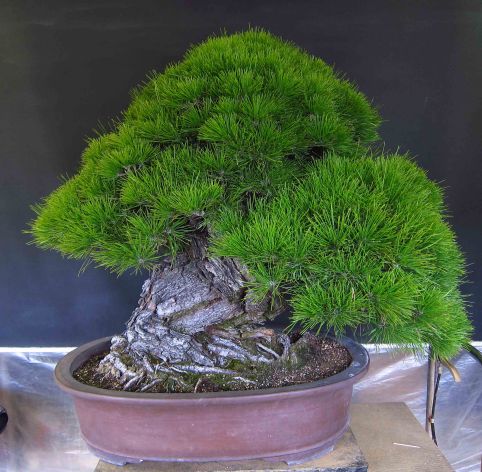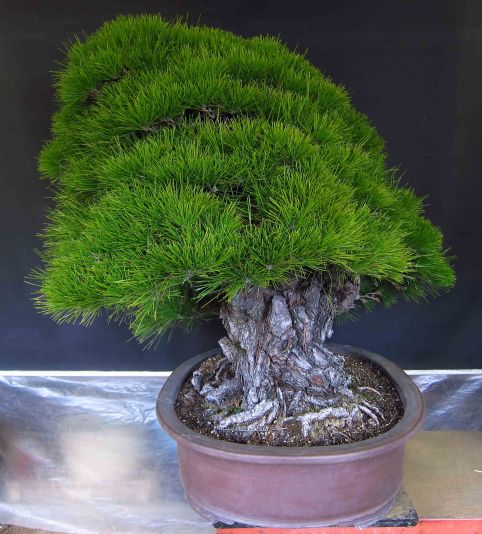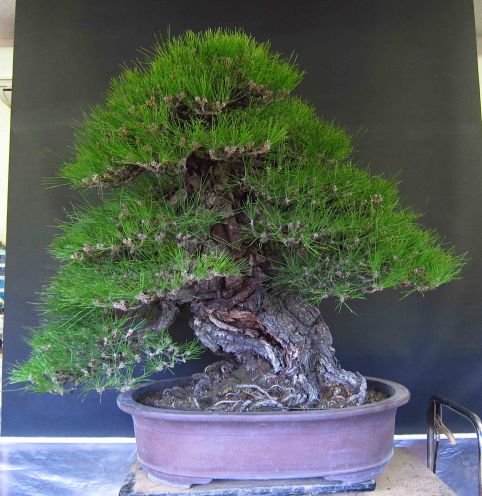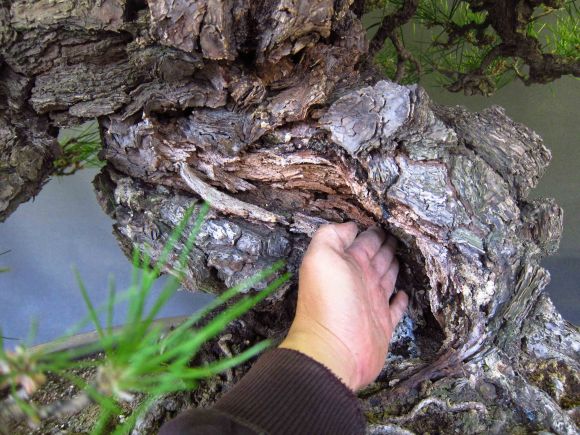 “Zuiou” 1996 Kokufu prize winner, Japanese Black Pine
“Zuiou” 1996 Kokufu prize winner, Japanese Black Pine
A few months ago I was fortunate enough to work on this large Japanese Black Pine. The work wasn’t major and involved thinning and pulling needles; standard stuff for Black Pines in the Winter. Just getting a chance to work on this tree was an amazing feeling for me because it tied my past bonsai career to my ending apprenticeship. What surprised me when I learned the history of this tree is how it has been around so many people who has influenced my bonsai work in the past and present. So close to me but unknown by me. In This post, I’m going to share with you the history of this Japanese Black Pine and some close up photos of the tree that makes it world-class.
The Beginning
Bonsai started for me in 2004 when I signed up for Boon Manakitivipart’s Intensive program in California. He was the person that really showed me that bonsai is so much more than a plant in a pot. As I worked with Boon year after year, we would look at old Japanese books and he would tell me stories of his studies in Japan and about his teacher, Mr. Kamiya. Boon showed me photos of Mr. Kamiya’s work and they would blow my mind. One of the photos being the one shown above. The photos stuck with me and setup a benchmark for me to strive towards. No small task, but a goal worth working hard for.
Mr. Kamiya entered this Japanese Black Pine known as Zuiou into the 70th annual Kokufu Bonsai Show in Tokyo in 1996. Kokufu-ten to this day is the biggest and most important show in Japan. Trees that win the Kokufu prize are elevated to being one of the best Bonsais in Japan. A prize so prestiges that a bonsai can only win it one time unless it undergoes such radical changes as to be unrecognizable. Zuiou belonged to well know bonsai collector Mr. Moriyama, which was Mr. Kamiya’s customer. In 1996, Zuiou won the Kokfu prize. This is all I knew of this tree till I started my apprenticeship at Aichien.
The Name
The name Zuiou was given to the tree by owner Mr. Moriyama. Zuiou translates to, “Rare King.” A sutable name for such a tree don’t you think? Only the great trees in Japan are given names and normally they are given by the owners of the tree. On rare occasions, the bonsai professional will name a tree. But beware, naming a tree that is not of very high quality will result in puzzled facial expressions from the Japanese… and me. 😉
Aichien
The first day of work at Aichien under the tutelage of Mr. Junichiro Tanaka was at Mr. Moriyama house. How exciting! First day and I’m going to see some great trees! After the work was finished I started snapping pictures of trees in his collection. 5 of Mr. Moriyama’s trees have won Kokufu prizes.
Within a week of my arrival we visited Daijuen which is a famous Black Pine nursery headed by Mr. Tohru Suzuki. That was the first time I saw Zuiou in person. Daijuen was taking care of it for Mr. Moriyama for the past couple of years. Since Mr. Kamiya’s passing, Daijuen and Aichien have both been helping Mr. Moriyama build and maintain his collection. I pointed the tree out to Mr. Tanaka in excitement and said I know this tree! He looked at me with a grin on his face and said, “Yes, famous tree, Aichien made it.” Such confidence when he said it too! I froze for a second coming to the realization that I was studying at a nursery that produced this tree! Mr. Tanaka then started telling me the story of Zuiou as I eagerly listened.
It turns out that this tree was collected back in the 1930s by a bonsai grower. Mr. Tanaka’s great-grandfather saw the tree and later sent his son to purchase it. At the time, it was only the trunk with wild branches everywhere. The Tanaka family spent the next 60 years completely redeveloping the branch structure and creating the silhouette we see today. The tree stayed at Aichien till 1995 when it was sold to Mr. Moriyama.
 The tree on display at the Aichien family show 1995.
The tree on display at the Aichien family show 1995.
 Zuiou displayed at Taikan-ten 2011. Next to the tree is Jonas Duprich from BonsaiTonight.com
Zuiou displayed at Taikan-ten 2011. Next to the tree is Jonas Duprich from BonsaiTonight.com
The Return of Zuiou
At the end of 2012, Mr. Moriyama decided to sell Zuiou to one of our customer Mr. Tomomatsu. All I can say is that the tree was not cheap. Once the tree changed hands, it stayed at Mr. Tomomatsu’s house for a few weeks and then was moved to Aichien. The day we went to pick up the tree was a cool day for me. Since 1996, Zuiou has seen a lot of action since it’s days back home and it was a highlight of my apprenticeship to see it returning to Aichien.
Zuiou Now
Zuiou was moved to Aichien in the Fall of 2012 and I was instructed to thin the branches and pull the needles. I was excited and yet comfortable working on the tree. I felt like I knew this tree all my life and it was just another days work at the nursery.
Lets take a look at the four sides of Zuiou and its dimensions. It was de-candled in July of 2012. I don’t believe the tree has seen much wire since 1996. The tree has been maintained by cutting all this time.
 Zuiou is nice and bushy after the de-candling. The tree overall has gotten slightly wider through the years. I suppose that happens to all of us too. 😉
Zuiou is nice and bushy after the de-candling. The tree overall has gotten slightly wider through the years. I suppose that happens to all of us too. 😉
Height is 34in (87cm) Width is 38in (97cm) Root Spread is 20in (51cm) Trunk Width is 12in (30cm)
Getting To Work!
I worked on the tree for about 12 hours cutting and removing needles. Pulling needles is pretty simple but what am I cutting? As I went through the tree, I removed branches from overcrowded areas and branches that were too strong or too long. The point of cutting and pulling needles is to help maintain a balanced tree. Different areas of the tree will try to over take other parts so its our job to keep the strong areas under control and get the weaker areas stronger. The ability of the individual needle bundles to get enough sunlight is very important.
 Here’s an example of a weak area relative to the rest of the tree. The end of the branch is dense because it’s getting enough light whereas the interior foliage of the same branch became weak because of the lack of sunlight (Note how the needles are not point up but down and out. This area wasn’t de-candle like the rest of the tree because it was weak. In this photo, I had already thinned out the apex to allow more light into this section. Hopefully we can get this area stronger and bring it up to speed with the rest of the branches. If we had not addressed this problem, the branch would get weaker year after year and eventually die off.
Here’s an example of a weak area relative to the rest of the tree. The end of the branch is dense because it’s getting enough light whereas the interior foliage of the same branch became weak because of the lack of sunlight (Note how the needles are not point up but down and out. This area wasn’t de-candle like the rest of the tree because it was weak. In this photo, I had already thinned out the apex to allow more light into this section. Hopefully we can get this area stronger and bring it up to speed with the rest of the branches. If we had not addressed this problem, the branch would get weaker year after year and eventually die off.
 Here’s an example of a very strong area on the tree. Notice how it’s dense and full. This is an area that needs to be controlled before it gets too strong and weakens the lower branches.
Here’s an example of a very strong area on the tree. Notice how it’s dense and full. This is an area that needs to be controlled before it gets too strong and weakens the lower branches.
 Here’s another example of a branch getting too strong and long and weaken the branches below. The branch below should be the one filling this area instead of a strong branch from the top. It’s time to cut!
Here’s another example of a branch getting too strong and long and weaken the branches below. The branch below should be the one filling this area instead of a strong branch from the top. It’s time to cut!
 That’s much better! I think that branch cost about 500 dollars. 😉 Now sunlight can get into the foliage below.
That’s much better! I think that branch cost about 500 dollars. 😉 Now sunlight can get into the foliage below.
 Note how the now exposed foliage is sparse and thin. This area should get stronger in the coming years and fill in the newly created hole.
Note how the now exposed foliage is sparse and thin. This area should get stronger in the coming years and fill in the newly created hole.
 Here’s an example of the results of de-candling in the previous Summer. In this case, we got two new growth bundles. I had already pulled the old needles and some of the new needles. Sometimes we get one or more than two. Normally we’ll reduce the bundles down to 1 or 2.
Here’s an example of the results of de-candling in the previous Summer. In this case, we got two new growth bundles. I had already pulled the old needles and some of the new needles. Sometimes we get one or more than two. Normally we’ll reduce the bundles down to 1 or 2.
After The Work
Now that the tree is thinned out, there is room for new foliage to grow and sunlight to reach all parts. One nice characteristic of this particular pine is that it had back buds everywhere! Some of them deep inside the tree too! This tree is not going to have problems growing new branches anytime soon. Here’s the four sides after the work.
Lets get a good look at the trunk from all sides!
 The front. Some or all of you are wondering at this moment, “what happened to the trunk?” What use to be a solid trunk has now got a big hollow in it. It turns out that this part of the trunk had been dead all along. I’ll into the details further along in the post.
The front. Some or all of you are wondering at this moment, “what happened to the trunk?” What use to be a solid trunk has now got a big hollow in it. It turns out that this part of the trunk had been dead all along. I’ll into the details further along in the post.
 Here’s a little perspective of how thick some of the bark is on this tree. The bark is about 2.5in (6.3cm) thick!
Here’s a little perspective of how thick some of the bark is on this tree. The bark is about 2.5in (6.3cm) thick!
 Here’s the front of the trunk as we look up into the tree. No shortage or bark! Amazingly old-looking!
Here’s the front of the trunk as we look up into the tree. No shortage or bark! Amazingly old-looking!
 The trunk from the tree’s left.
The trunk from the tree’s left.
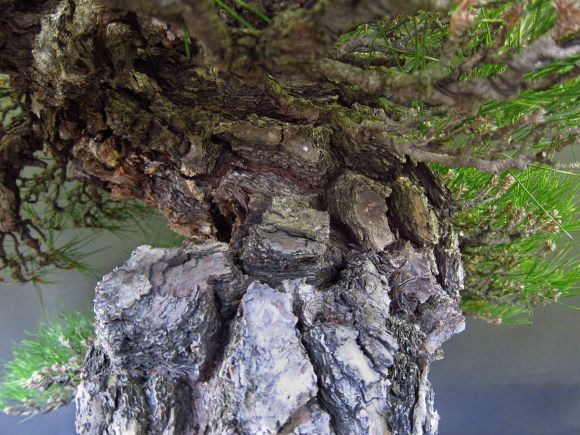 Tree’s left looking up at the tree.
Tree’s left looking up at the tree.
 The back of the tree (or perhaps the future front?) Lots of nice bark on this side especially long vertical strips. This bark character is highly valuable and sought after in Japan.
The back of the tree (or perhaps the future front?) Lots of nice bark on this side especially long vertical strips. This bark character is highly valuable and sought after in Japan.
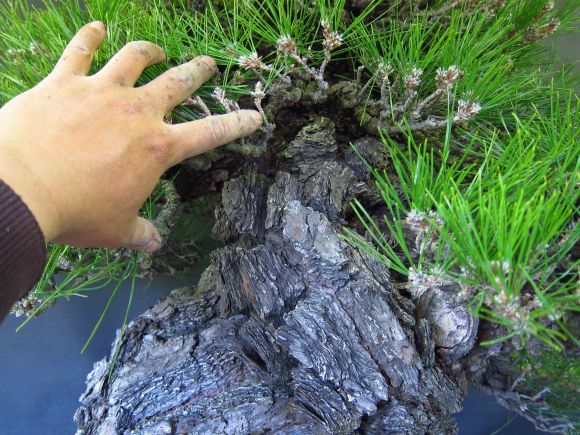 Here’s the back as we move up the trunk. Again, nice thick vertical strips of bark.
Here’s the back as we move up the trunk. Again, nice thick vertical strips of bark.
I didn’t include photos of the tree’s right side because the tree is leaning in that direction and it’s difficult to see anything.
Age Makes The Difference
One of key phrases we hear in the Bonsai community is, “make the tree look old.” But what does that really mean? The reason why we try to make our bonsai look old is to show its history and establishment. There’s plenty of young trees growing out in nature so seeing young tree doesn’t excite us as much. Very old trees are rare and when we can get that same feeling in our Bonsai, it makes it that much better. So in bonsai there are all sorts of techniques and tricks to make a tree look older but they all have their limits. At some point we need to let time take over and mature the tree. All great trees in Bonsai conveys age to the viewer. It’s not just the trunk that shows it, but everything else that’s attached to the trunk. The branches need to look old too. Lets look at some photos to see what I’m talking about.
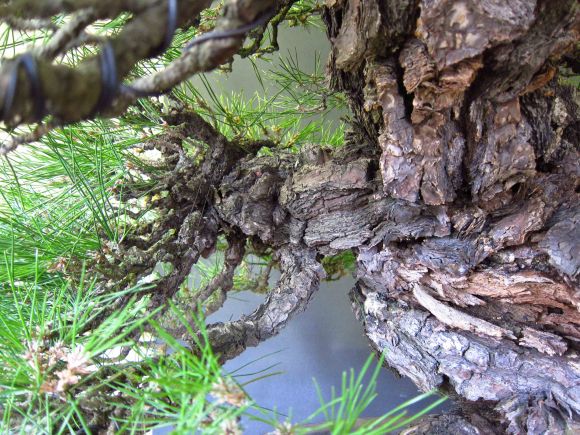 Zuiou’s main branch. Note that it’s no only thick, but very old. This transition from trunk to branch make sense. This is a concept that is not discussed a lot among bonsai enthusiast. We know how to get branches thicker (allow it to grow) but how do we produce the associated bark or characteristics of age? Just plain old TIME. This quality is present in all high quality bonsai of any species.
Zuiou’s main branch. Note that it’s no only thick, but very old. This transition from trunk to branch make sense. This is a concept that is not discussed a lot among bonsai enthusiast. We know how to get branches thicker (allow it to grow) but how do we produce the associated bark or characteristics of age? Just plain old TIME. This quality is present in all high quality bonsai of any species.
 Here’s an example of a main branch that is still in development. Note how the trunk has nice thick bark and the main branch has little bark. The transition at this point is not very good and is going to take some time to develop. This tree is quite large so it’s going to take well over 50 years to develop that transition. Hence why the Aichien family developed the branches of Zuiou for such a long time. I would say that Japanese Black Pines take the longest to develop into great bonsai than most other species. I’m sure there’s a few exceptions out there somewhere.
Here’s an example of a main branch that is still in development. Note how the trunk has nice thick bark and the main branch has little bark. The transition at this point is not very good and is going to take some time to develop. This tree is quite large so it’s going to take well over 50 years to develop that transition. Hence why the Aichien family developed the branches of Zuiou for such a long time. I would say that Japanese Black Pines take the longest to develop into great bonsai than most other species. I’m sure there’s a few exceptions out there somewhere.
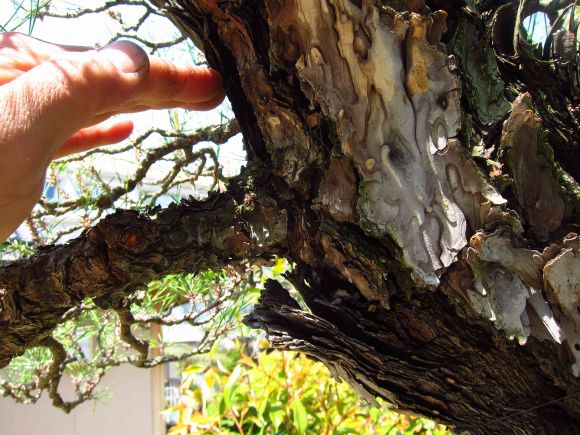 Another example of a young branch attached to an old trunk. This is another large Black Pine in development. That that great to look at huh? Two trees that won’t be ready to even compete in Kokufu till Mr. Tanaka’s grandson is an adult. His oldest son is currently 8 years old.
Another example of a young branch attached to an old trunk. This is another large Black Pine in development. That that great to look at huh? Two trees that won’t be ready to even compete in Kokufu till Mr. Tanaka’s grandson is an adult. His oldest son is currently 8 years old.
Now I’m not trying to discourage any of you from developing Japanese Black pines, but want to challenge those that want to take their bonsai to the next level. Also remember that this concept applies to every tree species and is useful to all of us. I believe this will also helps you see bonsai in a different way and appreciate the time and effort it takes to create great bonsai.
Lets Talk New Front!
 So what happened to the front? This flat cut is see in the back of the tree. I’m not sure if Mr. Tanaka’s grandfather cut it off or the person who collected it did. If you follow this cut…
So what happened to the front? This flat cut is see in the back of the tree. I’m not sure if Mr. Tanaka’s grandfather cut it off or the person who collected it did. If you follow this cut…
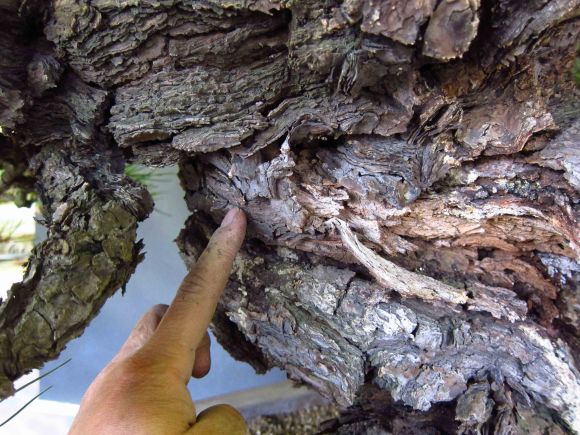 … it comes around to the front and into the dead section in the middle of the trunk.
… it comes around to the front and into the dead section in the middle of the trunk.
 Hence, hollow trunk. It just took about 70 years for the dead section to finally rot away.
Hence, hollow trunk. It just took about 70 years for the dead section to finally rot away.
So here is the issue. This once very powerful feeling tree has lost some of that feeling because of the hollow in the center of the trunk. Should be accept it for what it is or perhaps try to bring it back to its previous glory?
Now this is not an argument on if I think deadwood is a good feature or bad feature for Japanese Black Pine. My argument is that for this particular tree and style, a thick bark intact trunk looks much grander and older than an old trunk that is hollowed. There are plenty of other Black Pines out there with deadwood features that look great too.
 The back side could be a new alternative front. It has great bark features and is intact. Of course, the blunt cut branch on the right would be removed. Also, the main branch is much more visible on this side than the front. I talked to Mr. Tanaka and he agrees with the change but said it was up to the customer.
The back side could be a new alternative front. It has great bark features and is intact. Of course, the blunt cut branch on the right would be removed. Also, the main branch is much more visible on this side than the front. I talked to Mr. Tanaka and he agrees with the change but said it was up to the customer.
 So what entails if the customer does decide to remake the tree? The good news is that most of the lower branches are usable and only a few will be eliminated. The major changes comes in tilting the trunk forward and completely removing the current apex and redeveloping what is now a high back branch into the new apex. Estimated time to complete this change with aged branches according to Mr. Tanaka, “20 years.” Looks like the customer may have to sleep on this decision. 😉
So what entails if the customer does decide to remake the tree? The good news is that most of the lower branches are usable and only a few will be eliminated. The major changes comes in tilting the trunk forward and completely removing the current apex and redeveloping what is now a high back branch into the new apex. Estimated time to complete this change with aged branches according to Mr. Tanaka, “20 years.” Looks like the customer may have to sleep on this decision. 😉
So we’ll see what the customer thinks and see what happens to the tree. Hopefully I’ll be there to take photos if the tree does get changed. For the mean time, we’ll keep it growing well and healthy. I hope you enjoyed this post!
Thanks for reading.
If you’re interested in learning more about Japanese Black Pines or relevant things we’re doing this time of year, please visit some of my earlier post for helpful tips and information.
I Love the Smell of Pesticdes in the Morning! – In this post I talk about how we combat bad bugs at Aichien. De-candling and Stuff – In this post I talk about process of de-candling and thinning Japanese Black Pine. Mikawa Black Pines? – In this post I talk about the different types of Japanese Black Pines. Tanaka, Junichiro – In this post, we follow Mr. Tanaka in his steps to styling an old Japanese Black Pine. The Trident Maple Project and Summer Maple Work – In this post I talk about basic Trident Maple work during the Summer on one of my project trees.Please visit the Post Index tab for a list of post I’ve written in the past by category.
——————————————————————————————————-
If you are actively reading this blog, I would appreciate it if you subscribe to it (right column of the blog). This is one of the best ways for me to know how many people are reading. Thanks!

